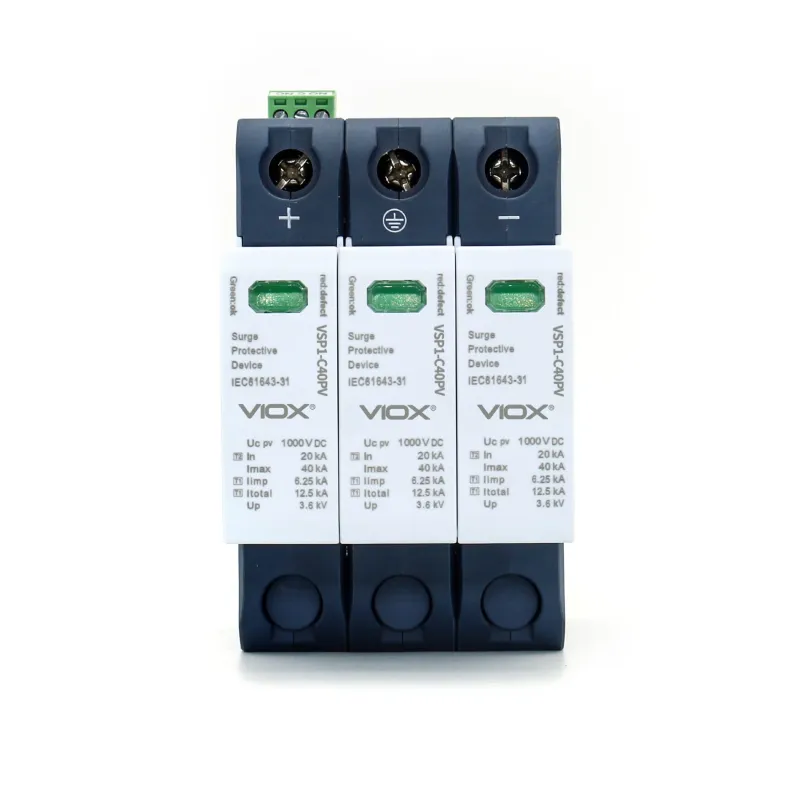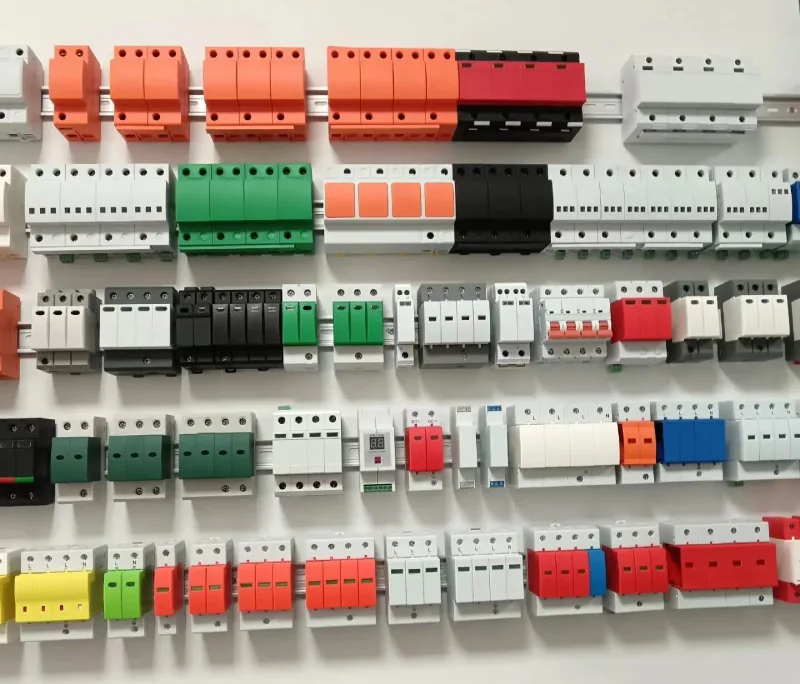Uc and Up are two critical voltage parameters that determine how effectively a Surge Protection Device (SPD) will protect your electrical equipment. Uc represents the maximum continuous operating voltage, while Up indicates the voltage protection level that limits surge voltage during activation. Understanding these parameters correctly ensures optimal surge protection and prevents costly equipment damage.
What Do Uc and Up Mean on SPD? Essential Definitions

Uc: Maximum Continuous Operating Voltage
Uc (Maximum Continuous Operating Voltage) is the maximum AC or DC voltage that can be continuously applied to the SPD without causing activation or degradation. This parameter determines when the SPD remains inactive during normal operating conditions.
Key characteristics of Uc:
- Represents the maximum effective value of AC voltage that can be continuously applied to SPD protection mode
- Must exceed the system’s nominal voltage to ensure proper operation
- If chosen too high, the SPD may fail to activate during surge events
- Exceeding Uc will cause the surge protector to overheat, accelerate aging, and potentially be damaged
Up: Voltage Protection Level
Up (Voltage Protection Level) is the maximum voltage across the terminals of the SPD when it is active, reached when the current flowing through the SPD equals the nominal discharge current (In).
Key characteristics of Up:
- For voltage switch-type surge protectors, Up is the maximum discharge voltage
- For clamping-type surge protectors, Up represents the peak voltage appearing across terminals during discharge
- Must be below the overvoltage withstand capability of protected equipment
- Lower Up values provide better protection for sensitive equipment

SPD Uc and Up Comparison Table
| Tham số | Uc (Maximum Continuous Operating Voltage) | Up (Voltage Protection Level) |
|---|---|---|
| Định nghĩa | Maximum voltage for continuous operation | Maximum voltage during surge protection |
| Chức năng | Determines SPD activation threshold | Limits surge voltage to equipment |
| Tiêu chí lựa chọn | Must exceed system nominal voltage | Must be below equipment withstand voltage |
| Typical Values (230V System) | 275V, 320V, 385V | 1.5kV, 2.5kV, 4kV |
| Safety Impact | Prevents premature activation | Prevents equipment damage |
| Chuẩn Tài Liệu Tham Khảo | Tiêu chuẩn IEC 61643-11 | Tiêu chuẩn IEC 61643-11 |

How to Select Uc Values for Different Applications
Uc Selection for Common Voltage Systems
Here is a table that shows the recommended Uc values for different electrical systems:
| Hệ Thống Điện Áp | Minimum Uc Required | Recommended Uc | Safety Margin |
|---|---|---|---|
| 220V Single-Phase | 255V | 275V | 25% |
| 230V Single-Phase | 255V | 275V-320V | 20-39% |
| 380V Three-Phase | 320V | 385V | 21% |
| 400V Three-Phase | 460V | 500V | 25% |
💡 Chuyên Gia Mẹo: For 230V systems, choose an SPD with Uc rating of at least 275V, with many applications using Uc values of 320V-385V to accommodate voltage fluctuations and system faults.
Step-by-Step Uc Selection Process
- Identify System Voltage
- Determine nominal operating voltage (Un)
- Check system earthing arrangement (TN, TT, IT)
- Consider voltage fluctuations (typically ±10%)
- Calculate Minimum Uc Requirements
- When single-phase ground fault occurs, remaining phases experience √3 times normal phase voltage
- Apply safety factor: Uc ≥ 1.3 × Un (recommended)
- Select Appropriate Uc Value
- Choose from standard values: 255V, 275V, 320V, 385V, 420V
- Balance between adequate margin and effective protection
Dr. Trước An Toàn Cảnh Báo: Choosing Uc too high results in SPD failing to start protection actions and inability to effectively discharge surge currents.
Up Selection Guide: Ensuring Adequate Equipment Protection
Understanding Up Requirements
To ensure effective protection, the voltage protection level Up must be lower than the rated impulse voltage Uw of the equipment to be protected, with a general safety margin of at least 20% (Up ≤ 0.8 × Uw).
Equipment Impulse Withstand Voltages
| Equipment Category | Typical Impulse Withstand (Uw) | Required Up (Max) |
|---|---|---|
| Sensitive Electronics | 1.5kV | ≤1.2kV |
| Standard IT Equipment | 2,5kV | ≤2,0kV |
| Thiết bị công nghiệp | 4.0kV | ≤3,2kV |
| Heavy Industrial | 6.0kV | ≤4.8kV |
Up Selection Process
- Determine Equipment Requirements
- Identify rated impulse voltage Uw of protected equipment
- Consider EMC immunity levels per IEC 61000-4-5
- Apply Safety Margins
- Calculate maximum allowable Up: Up ≤ 0.8 × Uw
- For 230/400V installations, installed Up should generally be ≤2.5kV
- Consider Installation Effects
- Account for voltage drops in connecting wires
- Factor in coordination with upstream/downstream SPDs
Common Uc and Up Values by Application
Ứng dụng dân dụng
| Ứng dụng | Recommended Uc | Typical Up | Mức độ bảo vệ |
|---|---|---|---|
| Main Panel (230V) | 275V | 1.5-2.5kV | Type 2 |
| Sub-panels | 275V | 1.5kV | Type 2 |
| Sensitive Equipment | 275V | ≤1.2kV | Type 3 |
Commercial/Industrial Applications
| Ứng dụng | Recommended Uc | Typical Up | Mức độ bảo vệ |
|---|---|---|---|
| Main Distribution (400V) | 460V | 2.5-4kV | Type 1+2 |
| Trung tâm điều khiển động cơ | 385V | 2,5kV | Type 2 |
| IT Equipment Protection | 275V | 1.5kV | Type 3 |
💡 Chuyên Gia Mẹo: In practical applications, Uc values of 320V-385V are commonly chosen for three-phase systems to ensure adequate margin even as SPD ages.
Relationship Between Uc and Up Values
How Uc Affects Up Performance
The SPD’s Up value is related to the Uc value – larger Uc values generally result in higher Up values. This relationship impacts protection effectiveness:
Key Relationships:
- Higher Uc = Higher activation threshold
- Higher Uc = Typically higher Up values
- Higher Up = Reduced protection for sensitive equipment
- Larger Uc values result in higher starting voltage and residual voltage
Optimization Strategy
- Select minimum adequate Uc
- Meet system voltage requirements
- Allow for voltage fluctuations
- Avoid unnecessarily high values that compromise protection
- Verify Up compatibility
- Ensure Up < equipment withstand voltage
- Consider coordination requirements
- Account for installation voltage drops
SPD Selection by System Type
TN System Requirements
For TN systems (TN-C, TN-S, TN-C-S), where neutral is earthed, different SPD configurations are required:
| Loại Hệ Thống | SPD Configuration | Typical Uc | Ghi chú |
|---|---|---|---|
| TN-C | 3P (L-PEN protection) | 275V-385V | Combined neutral-earth |
| TN-S | 3P+N (L-PE, N-PE) | 275V-385V | Separate neutral, earth |
| TN-C-S | 3P+N at changeover | 275V-385V | Transition point critical |
TT System Requirements
TT systems require protection against both common-mode and differential-mode overvoltages due to earth impedance asymmetry.
IT System Requirements
IT systems have no direct earth connection or high impedance earth connection, allowing continued operation during single earth faults.

Troubleshooting Common Uc and Up Issues
Problem: SPD Not Activating During Surges
Nguyên nhân có thể xảy ra:
- Uc value chosen too high for system conditions
- Incorrect system earthing assessment
- SPD degradation over time
Giải pháp:
- Recalculate system voltages including fault conditions
- Select lower Uc value within safe operating range
- Verify earthing system type and configuration
Problem: Equipment Damage Despite SPD Installation
Nguyên nhân có thể xảy ra:
- Up value exceeds equipment withstand voltage
- Inadequate coordination between SPD levels
- Poor SPD installation or grounding
Giải pháp:
- Ensure Up ≤ 0.8 × equipment impulse withstand voltage
- Install coordinated SPD system at multiple levels
- Verify low-resistance earth connections
Problem: Frequent SPD Replacement
Nguyên nhân có thể xảy ra:
- Uc value too close to system operating voltage
- Excessive temporary overvoltages
- Environmental degradation
Giải pháp:
- Increase Uc safety margin
- Address upstream power quality issues
- Implement regular maintenance schedule
Yêu Cầu an toàn và Tuân thủ Mã
IEC Standard Requirements
Tiêu chuẩn IEC 61643-11 specifies requirements for SPDs in low-voltage distribution systems, while IEC 62305-4 addresses lightning protection system requirements.
Key Safety Requirements:
- Type 1 SPD with Iimp ≥12.5kA for installations with lightning protection systems
- Type 2 SPD with In ≥5kA for standard AC installations
- Proper coordination between protection levels
Installation Safety Guidelines
⚠️ Critical Safety Points:
- Installation must be performed by certified electricians
- Proper grounding is essential for SPD operation
- Regular inspection and maintenance required
- SPDs should include failure indication features
Chuyên Gia Lựa Chọn Lời Khuyên
Đề Nghị Chuyên Nghiệp
- Always Choose Certified SPDs
- Select SPDs with UL or IEC certification from reputable testing facilities
- Verify compliance with local electrical codes
- Consider Long-term Performance
- Select Uc values with adequate margin to account for aging
- Choose higher In ratings for longer SPD life
- Plan for Coordination
- Multiple SPD devices must be coordinated according to Regulation 534.4.4.5
- Consider energy coordination between protection levels
- Account for Future Changes
- Design for potential system voltage modifications
- Consider equipment upgrades and sensitivity changes
💡 Chuyên Gia Mẹo: Selection of higher surge current ratings doesn’t always provide better protection but does provide longer SPD life.
Những Câu Hỏi Thường
What happens if Uc is too low for my system?
If Uc is below the system operating voltage, the SPD will activate continuously, leading to immediate failure and potential safety hazards. Always ensure Uc exceeds maximum expected system voltage.
Can I use an SPD with Up higher than my equipment rating?
No, the Up value must be lower than your equipment’s impulse withstand voltage with at least a 20% safety margin (Up ≤ 0.8 × Uw). Higher Up values may allow damaging voltages to reach your equipment.
How do I determine my equipment’s impulse withstand voltage?
Check equipment specifications for rated impulse voltage (Uw) or overvoltage category. Most sensitive equipment in 230/400V installations should be protected to overvoltage category II (2.5kV).
Should I choose the highest available Uc value for maximum safety?
No, larger Uc values are not always better. Higher Uc results in higher starting voltage and residual voltage, potentially compromising protection effectiveness. Select the optimal Uc based on your system requirements.
How often should SPDs be inspected?
Regular inspection is essential, with SPDs featuring non-functional indicators requiring immediate replacement. Schedule annual inspections or after significant surge events.
What’s the difference between Type 1, Type 2, and Type 3 SPDs?
Type 1 SPDs handle direct lightning strikes (10/350 µs), Type 2 SPDs provide main installation protection (8/20 µs), and Type 3 SPDs protect individual equipment near loads.
Kết luận: Lựa chọn đúng đắn
Understanding Uc and Up parameters is essential for effective surge protection. Properly selected Uc values ensure SPDs activate appropriately during surge events, while correct Up values guarantee adequate equipment protection.
Key takeaways for optimal selection:
- Choose Uc with adequate safety margin above system voltage
- Ensure Up remains below equipment withstand capability
- Consider system earthing arrangement and fault conditions
- Implement coordinated protection across multiple levels
- Prioritize certified SPDs with proper installation
For complex installations or critical applications, consult with qualified electrical engineers to ensure optimal SPD selection and system protection. The investment in proper surge protection far outweighs the cost of replacing damaged equipment and system downtime.
Liên quan
Thiết bị chống sét lan truyền (SPD) là gì?
SPD chuyển hướng hoặc giới hạn điện áp thoáng qua như thế nào để đảm bảo an toàn và độ tin cậy
Cách chọn SPD phù hợp cho hệ thống điện mặt trời của bạn
Tại sao chúng ta sử dụng AC trong nhà thay vì DC
Thiết bị chống sét lan truyền Loại 1 so với Loại 2 so với Loại 3


